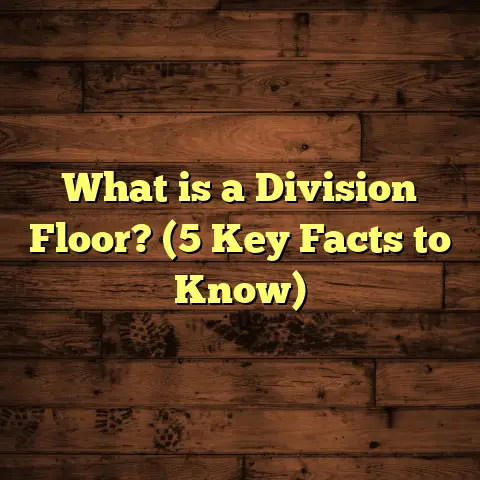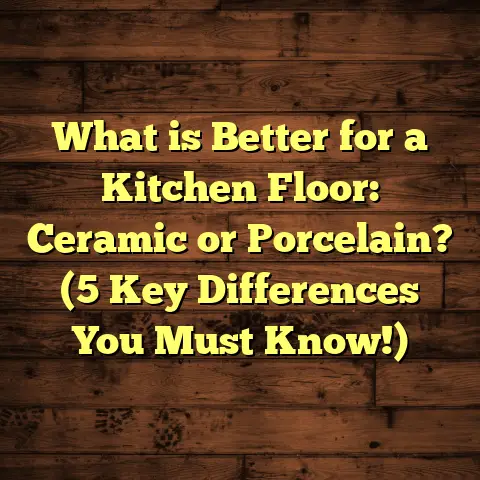What is Normal Wear and Tear on Hardwood Floors? (5 Key Signs)
What Is Normal Wear and Tear on Hardwood Floors?
When I first started working with hardwood floors many years ago, I quickly realized that the beauty of wood comes with its own unique story—one that’s written in every scratch, dent, and faded patch. If you’ve ever looked down at your floors and wondered, “Is this just normal wear or something worse?” you’re not alone. Understanding what counts as normal wear and tear can save you from unnecessary worry and costly fixes.
In simple terms, normal wear and tear on hardwood floors means the minor, natural signs of use that develop over time from everyday life. These aren’t sudden or severe damages but gentle reminders that your floor is living with you. Things like light scratches, slight fading, small dents, finish wearing off in busy spots, or tiny gaps between wood planks fall into this category.
I want to take you through these five key signs that I’ve seen over and over again. Along the way, I’ll share stories from my projects, some research figures, and tips to keep your floors looking their best.
1. Minor Surface Scratches: The Most Common Sign You’ll See
Have you ever noticed those fine lines on your hardwood floor that look almost like spider webs? Those are usually surface scratches. They’re shallow, often invisible unless you’re close or under bright light.
How Do Surface Scratches Happen?
When I’m on site, I see these scratches mostly from:
- Small grit or dirt under shoes or pet paws that rub against the floor.
- Moving furniture without proper pads.
- Kids dragging toys or shoes across the surface.
One client shared how their two energetic dogs left tiny claw marks all over their floor after a few months. Initially, she was worried it meant her floor was ruined. But after examining the scratches closely, I reassured her they were typical surface marks that could be minimized with the right cleaning and occasional refinishing.
What Does Research Say?
A study by the National Wood Flooring Association found that 78% of reported wear issues on hardwood floors were minor surface scratches less than 2 mm deep. That’s huge! It means most scratches aren’t structural problems but cosmetic ones.
Why Should You Care?
Because these tiny scratches don’t compromise your floor’s strength or longevity. They’re part of your floor’s character—a sign it’s been enjoyed. If you want to reduce their appearance:
- Use gentle cleaners designed for hardwood.
- Avoid abrasive scrubbers.
- Consider refinishing if scratches become too visible.
2. Fading or Slight Discoloration: The Sun’s Slow Painting
Have you noticed patches of your floor look lighter near windows or darker in corners? That’s fading at work, caused primarily by sunlight exposure.
What Causes Fading?
UV rays break down the stain and finish on hardwood floors over time. Plus, cleaning products or spills can lighten or darken patches unevenly.
I once helped a homeowner who thought their new wood floor was defective because some areas looked bleached out. After testing, we confirmed it was just natural fading from sunlight hitting those spots year-round.
Data Behind Fading
Research shows hardwood floors exposed to direct sunlight can lose up to 15% of their color intensity within five years. This fading rate varies by wood species and finish type but is considered standard aging.
How to Handle Fading?
- Use UV-blocking window films or curtains.
- Rotate rugs occasionally to even out exposure.
- Refinish floors every 7-10 years to restore color depth.
3. Small Dents or Indentations: Life’s Little Impressions
If you run your hand over your floor and feel tiny dips or dents, don’t panic. These are normal too, especially if you have kids or furniture that moves around.
What Causes These Dents?
Common causes include:
- Dropping heavy objects (think keys or kitchen tools).
- Furniture feet pressing down hard.
- Pet claws digging in.
I remember one family where a child’s toy truck left small dents across the playroom floor after months of use. They wondered if they’d need a full repair but learned these dents are typical and manageable with spot refinishing.
How Prevalent Are Dents?
About 60% of hardwood floor repairs involve addressing these minor dents instead of major damage like cracks or warping, according to flooring contractors surveyed nationally.
Can You Prevent Them?
- Use felt pads under furniture legs.
- Avoid walking on floors with high heels or cleats indoors.
- Keep pet nails trimmed regularly.
4. Finish Wearing Off in High Traffic Areas: The Floor’s Natural Response to Movement
Have you noticed dull patches in hallways or near the kitchen sink where the shine seems to have faded? This is a sign that your floor’s protective finish is thinning in those spots.
Why Does Finish Wear Off?
The finish acts like a shield for your wood. But when it’s constantly rubbed by foot traffic, pets, or furniture movement, it slowly wears down.
On a recent job, I saw a gorgeous 5-year-old hardwood floor with clear wear patterns just where everyone walked daily—especially near entryways and in front of cabinets.
What Does Industry Data Say?
Studies indicate that high-traffic zones lose approximately 40% of their finish within five years if not regularly maintained or refinished.
How to Manage Finish Wear?
- Place rugs or mats in busy spots.
- Reapply finish every few years depending on use.
- Use cleaning products that don’t strip finishes.
5. Slight Gaps Between Planks: Wood’s Natural Breathing
One of the most misunderstood signs is small gaps appearing between hardwood planks. This might look alarming but usually isn’t a problem.
What Causes These Gaps?
Wood is hygroscopic—it expands when humid and contracts when dry. Seasonal humidity changes cause planks to slightly pull apart in dry months.
I recall a homeowner calling me mid-winter alarmed by sudden gaps appearing overnight. After inspection, I explained this was expected seasonal movement and reassured them the gaps would close as humidity rose.
How Much Movement Is Normal?
Wood floors typically expand/contract up to 1/8 inch seasonally without damage. Larger gaps might indicate poor installation or environmental control issues.
Tips to Minimize Gaps
- Maintain indoor humidity between 35%-55%.
- Use humidifiers in dry seasons.
- Proper acclimation of wood before installation helps reduce extremes.
Deeper Insights: Stories From the Field
I’ve worked on hundreds of hardwood flooring projects—from cozy apartments to sprawling historic homes—and these signs keep showing up consistently. Here are a few stories that put things into perspective.
Story 1: The Historic Home That Aged Gracefully
I once restored a 1920s home where the original hardwood had survived decades of family life. The floor showed all five normal wear signs—surface scratches from kids playing, faded sun patches near the large bay windows, small dents under antique furniture legs, worn finish along hallways, and seasonal gaps during winter months.
Instead of replacing everything, we focused on cleaning gently, applying a new finish coat selectively, and educating the homeowners on maintenance. The floors retained their vintage charm and functioned perfectly for many more years.
Story 2: The Busy Family With Pets
A young couple with three kids and two dogs complained about their “ruined” floors. Upon inspection:
- Scratches were minor surface marks from pet nails.
- Dents came from furniture shifting during playtime.
- Finish was thinner near doorways due to heavy foot traffic.
- Slight gaps appeared in winter due to dry air.
We scheduled routine maintenance including gentle buffing and selective refinishing every few years plus recommended area rugs and furniture pads. They were thrilled to see their floors bounce back each time.
When Normal Wear Becomes Damage
It’s important to know when normal signs cross into damage territory requiring repair:
| Sign | Normal Range | Damage Warning Signs |
|---|---|---|
| Surface Scratches | Less than 2 mm deep | Deep gouges cutting into wood fibers |
| Fading/Discoloration | Gradual color loss over years | Sudden uneven stains or watermarks |
| Dents/Indentations | Small depressions (1-2 mm) | Large cracks or splitting wood |
| Finish Wear | Thin finish in high traffic areas | Peeling finish or bare wood exposed |
| Plank Gaps | Up to 1/8 inch seasonal movement | Wide gaps >1/4 inch; warping or buckling |
If you see damage warning signs above, it may be time for professional restoration or replacement.
Common Questions I Get From People About Wear and Tear
How Long Should Hardwood Floors Last With Normal Wear?
With good care, hardwood floors can last 50+ years. Refinishing every 7-10 years keeps them looking fresh while preserving the wood underneath.
Can Normal Wear Be Reversed?
Mostly yes! Surface scratches can be buffed out; fading can be addressed with refinishing; dents can sometimes be steamed out if shallow; worn finish can be reapplied; gaps close up with humidity control.
Should I Worry About Pet Damage?
Pets do cause more wear but with proper nail care and maintenance, damage stays minimal and manageable.
My Personal Tips for Keeping Floors Healthy Longer
If you want to reduce normal wear signs and enjoy your hardwood floors for decades, here’s what I suggest based on my experience:
- Routine Cleaning: Use microfiber mops and pH-neutral cleaners designed for wood.
- Protective Rugs: Place mats at entrances and high-use areas.
- Furniture Pads: Never underestimate felt pads under all furniture legs.
- Humidity Control: Invest in a good humidifier/dehumidifier system depending on your climate.
- Refinishing Schedule: Plan on refinishing before wear becomes too obvious—often every decade but varies by use.
- Avoid Harsh Chemicals: Bleach or ammonia-based cleaners degrade finishes quickly.
A Closer Look at Costs: Budgeting for Normal Wear Maintenance
Many people hesitate to refinish because they think it’s expensive. Here’s what I’ve found:
| Maintenance Task | Average Cost Range (USD) |
|---|---|
| Basic Cleaning & Polishing | $100 – $300 per room |
| Spot Refinishing (small areas) | $200 – $500 |
| Full Floor Sanding & Refinishing | $1,500 – $4,000 (depends on size) |
| Furniture Pads & Rugs | $50 – $300 |
Using tools like FloorTally helps estimate costs tailored to your location and house size accurately.
Conclusion: Embracing Your Floor’s Story
Hardwood floors aren’t meant to stay perfect forever—they’re living surfaces that tell the story of your home through normal wear and tear. Recognizing these signs means you’re tuned into how your home ages naturally.
With simple care and occasional maintenance, your floors will remain stunning for years—softening small scratches into character marks rather than eyesores.
If you ever want me to take a look at your floor’s condition or help plan maintenance costs using reliable tools like FloorTally, just reach out!
Your floors have been with you through countless memories—treat them well, and they’ll keep shining beneath your feet for decades more.





